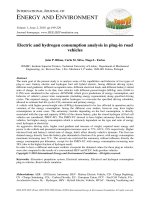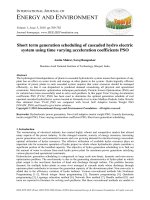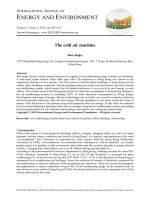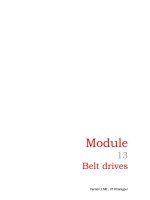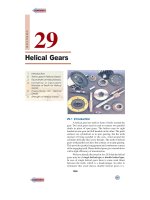electric machine ch04
Bạn đang xem bản rút gọn của tài liệu. Xem và tải ngay bản đầy đủ của tài liệu tại đây (1018.52 KB, 21 trang )
Chapter 4 Introduction to Rotating Machines
The objective of this chapter is to introduce and discuss some of the principles underlying the
performance of electric machinery, both ac and dc machines.
§4.1 Elementary Concepts
Voltages can be induced by time-varying magnetic fields. In rotating machines, voltages are
generated in windings or groups of coils by rotating these windings mechanically through a
magnetic field, by mechanically rotating a magnetic field past the winding, or by designing the
magnetic circuit so that the reluctance varies with rotation of the rotor.
The flux linking a specific coil is changed cyclically, and a time-varying voltage is
generated.
Electromagnetic energy conversion occurs when changes in the flux linkage result from
mechanical motion.
A set of such coils connected together is typically referred to as an armature winding, a
winding or a set of windings carrying ac currents.
In ac machines such as synchronous or induction machines, the armature winding is
typically on the stator. (the stator winding)
In dc machines, the armature winding is found on the rotor. (the rotor winding)
Synchronous and dc machines typically include a second winding (or set of windings),
referred to as the field winding, which carrys dc current and which are used to produce the
main operating flux in the machine.
In dc machines, the field winding is found on the stator.
In synchronous machines, the field winding is found on the rotor.
Permanent magnets can be used in the place of field windings.
In most rotating machines, the stator and rotor are made of electrical steel, and the
windings are installed in slots on these structures. The stator and rotor structures are
typically built from thin laminations of electrical steel, insulated from each other, to reduce
eddy-current losses.
§4.2 Introduction to AC And DC Machines
§4.2.1 AC Machines
Traditional ac machines fall into one of two categories: synchronous and induction.
In synchronous machines, rotor-winding currents are supplied directly from the stationary
frame through a rotating contact.
In induction machines, rotor currents are induced in the rotor windings by a combination of
the time-variation of the stator currents and the motion of the rotor relative to the stator.
Synchronous Machines
Fig. 4.4: a simplified salient-pole ac synchronous generator with two poles.
The armature winding is on the stator, and the field winding is on the rotor.
The field winding is excited by direct current conducted to it by means of stationary
carbon brushes that contact rotating slip rings or collector rings.
It is advantages to have the single, low-power field winding on the rotor while having
the high-power, typically multiple-phase, armature winding on the stator.
Armature winding
consists of a single coil of turns. ),( aa − N
Conductors forming these coil sides are connected in series by end connections.
The rotor is turned at a constant speed by a source of mechanical power connected to its
shaft. Flux paths are shown schematically by dashed lines.
1
Figure 4.4 Schematic view of a simple, two-pole, single-phase synchronous generator.
Assume a sinusoidal distribution of magnetic flux in the air gap of the machine in Fig. 4.4.
The radial distribution of air-gap flux density
B
is shown in Fig. 4.5(a) as a function
of the spatial angle
θ
around the rotor periphery.
As the rotor rotates, the flux –linkages of the armature winding change with time and
the resulting coil voltage will be sinusoidal in time as shown in Fig 4.5(b). The
frequency in cycles per second (Hz) is the same as the speed of the rotor in revolutions
in second (rps).
A two-pole synchronous machine must revolve at 3600 rpm to produce a 60-Hz voltage.
Note the terms “rpm” and “rps”.
Figure 4.5 (a) Space distribution of flux density and (b) corresponding waveform of
the generated voltage for the single-phase generator of Fig. 4.4.
A great many synchronous machines have more than two poles. Fig 4.6 shows in
schematic form a four-pole single-phase generator.
The field coils are connected so that the poles are of alternate polarity.
The armature winding consists of two coils ),(
11
aa
−
and connected in
series by their end connections.
),(
22
aa −
There are two complete wavelengths, or cycles, in the flux distribution around the
periphery, as shown in Fig. 4.7.
The generated voltage goes through two complete cycles per revolution of the rotor.
The frequency in Hz is thus twice the speed in rps.
2
Figure 4.6 Schematic view of a simple, four-pole, single-phase synchronous generator.
Figure 4.7 Space distribution of the air-gap flux density in an idealized,
four-pole synchronous generator.
When a machine has more than two poles, it is convenient to concentrate on a single pair of
poles and to express angles in electrical degrees or electrical radians rather than in physical
units.
One pair of poles equals 360 electrical degrees or 2π electrical radians.
Since there are poles/2 wavelengths, or cycles, in one revolution, it follows that
aea
2
poles
θθ
⎟
⎠
⎞
⎜
⎝
⎛
= (4.1)
where
ea
θ
is the angle in electrical units and
a
θ
is the spatial angle.
The coil voltage of a multipole machine passes through a complete cycle every time a
pair of poles sweeps by, or (poles/2) times each revolution. The electrical frequency
of the voltage generated is therefore
e
f
Hz
602
poles
e
n
f
⎟
⎠
⎞
⎜
⎝
⎛
= (4.2)
where
is the mechanical speed in rpm. Note that n
me
)poles/2(
ω
ω
=
.
The rotors shown in Figs. 4.4 and 4.6 have salient, or projecting, poles with concentrated
windings. Fig. 4.8 shows diagrammatically a nonsalient-pole, or cylindrical, rotor.
The field winding is a two-pole distributed winding; the coil sides are distributed in
multiple slots around the rotor periphery and arranged to produce an approximately
sinusoidal distribution of radial air-gap flux.
Most power systems in the world operate at frequencies of either 50 or 60 Hz.
A salient-pole construction is characteristic of hydroelectric generators because
hydraulic turbines operate at relatively low speeds, and hence a relatively large number
of poles is required to produce the desired frequency.
Steam turbines and gas turbines operate best at relatively high speeds, and turbine-
driven alternators or turbine generators are commonly two- or four-pole cylindrical-
rotor machines.
3
Figure 4.8 Elementary two-pole cylindrical-rotor field winding.
Most of the world’s power systems are three-phase systems. With very few exceptions,
synchronous generators are three-phase machines.
A simplified schematic view of a three-phase, two-pole machine with one coil per phase
is shown in Fig. 4.12(a)
Fig. 4.12(b) depicts a simplified three-phase, four-pole machine. Note that a minimum
of two sets of coils must be used. In an elementary multipole machine, the minimum
number of coils sets is given by one half the number of poles.
Note that coils and ),( aa − ),( aa
′
−
′
can be connected in series or in parallel. Then
the coils of the three phases may then be either Y- or ∆-connected. See Fig. 4.12(c).
Figure 4.12 Schematic views of three-phase generators: (a) two-pole, (b) four-pole, and
(c) Y connection of the windings.
The electromechanical torque is the mechanism through which a synchronous generator
converts mechanical to electric energy.
When a synchronous generator supplies electric power to a load, the armature current
creates a magnetic flux wave in the air gap that rotates at synchronous speed.
This flux reacts with the flux created by the field current, and an electromechanical
torque results from the tendency of these two magnetic fields to align.
In a generator this torque opposes rotation, and mechanical torque must be applied from
the prime mover to sustain rotation.
The counterpart of the synchronous generator is the synchronous motor.
Ac current supplied to the armature winding on the stator, and dc excitation is supplied
to the field winding on the rotor. The magnetic field produced by the armature currents
rotates at synchronous speed. (Why?)
To produce a steady electromechanical torque, the magnetic fields of the stator and rotor
must be constant in amplitude and stationary with respect to each other.
In a motor the electromechanical torque is in the direction of rotation and balances the
opposing torque required to drive the mechanical load.
4
In both generators and motors, an electromechanical torque and a rotational voltage are
produced which are the essential phenomena for electromechanical energy conversion.
Note that the flux produced by currents in the armature of a synchronous motor rotates
ahead of that produced by the field, thus pulling on the field (and hence on the rotor) and
doing work. This is the opposite of the situation in a synchronous generator, where the
field does work as its flux pulls on that of the armature, which is lagging behind.
Induction Machines
Alternating currents are applied directly to the stator windings. Rotors currents are then
produced by induction, i.e., transformer action.
Alternating currents flow in the rotor windings of an induction machine, in contrast to a
synchronous machine in which a field winding on the rotor is excited with dc current.
The induction machine may be regarded as a generalized transformer in which electric
power is transformed between rotor and stator together with a change of frequency and
a flow of mechanical power.
The induction motor is the most common of all motors.
The induction machine is seldom used as a generator.
In recent years it has been found to be well suited for wind-power applications.
It may also be used as a frequency changer.
In the induction motor, the stator windings are essentially the same as those of a
synchronous machine. The rotor windings are electrically short-circuited.
The rotor windings frequently have no external connections.
Currents are induced by transformer action from the stator winding.
Squirrel-cage induction motor: relatively expensive and highly reliable.
The armature flux in the induction motor leads that of the rotor and produces an
electromechanical torque.
The rotor does not rotate synchronously.
It is the slipping of the rotor with respect to the synchronous armature flux that gives
rise to the induced rotor currents and hence the torque.
Induction motors operate at speeds less than the synchronous mechanical speed.
A typical speed-torque characteristic for an induction motor is shown in Fig. 4.15.
Figure 4.15 Typical induction-motor speed-torque characteristic.
§4.2.2 DC Machines
DC Machines
There are two sets of windings in a dc machine.
The armature winding is on the rotor with current conducted from it by means of carbon
brushes.
The field winding is on the stator and is excited by direct current.
An elementary two-pole dc generator is shown in Fig. 4.17.
Armature winding: , ),( aa −
o
180pitch =
5
The rotor is normally turned at a constant speed by a source of mechanical power
connected the shaft.
Figure 4.17 Elementary dc machine with commutator.
The air-gap flux distribution usually approximates a flat-topped wave, rather than the
sine wave found in ac machines, and is shown in Fig. 4.18(a).
Rotation of the coil generates a coil voltage which is a time function having the same
waveform as the spatial flux-density distribution.
The voltage induced in an individual armature coil is an alternating voltage and
rectification is produced mechanically by means of a commutator. Stationary carbon
brushes held against the commutator surface connect the winding to the external
armature terminal.
The need for commutation is the reason why the armature windings are placed on the
rotor.
The commutator provides full-wave rectification, and the voltage waveform between
brushes is shown in Fig. 4.18(b).
Figure 4.18 (a) Space distribution of air-gap flux density in an elementary dc machine;
(b) waveform of voltage between brushes.
It is the interaction of the two flux distributions created by the direct currents in the field
and the armature windings that creates an electromechanical torque.
If the machine is acting as a generator, the torque opposes rotation.
6
If the machine is acting as a motor, the torque acts in the direction of the rotation.
§4.3 MMF of Distributed Windings
Most armatures have distributed windings, i.e. windings which are spread over a number of
slots around the air-gap periphery.
The individual coils are interconnected so that the result is a magnetic field having the
same number of poles as the field winding.
Consider Fig. 4.19(a).
Full-pitch coil: a coil which spans 180 electrical degrees.
In Fig. 4.19(b), the air gap and winding are in developed form (laid out flat) and the
air-gap mmf distribution is shown by the steplike distribution of amplitude
. 2/Ni
Figure 4.19 (a) Schematic view of flux produced by a concentrated, full-pitch winding in a machine
with a uniform air gap. (b) The air-gap mmf produced by current in this winding.
§4.3.1 AC Machines
It is appropriate to focus our attention on the space-fundamental sinusoidal component of the
air-gap mmf.
In the design of ac machines, serious efforts are made to distribute the coils making up the
windings so as to minimize the higher-order harmonic components.
The rectangular air-gap mmf wave of the concentrated two-pole, full-pitch coil of Fig.
4.19(b) can be resolved to a Fourier series comprising a fundamental component and a
series of odd harmonics.
The fundamental component and its amplitude are
agl
F
ag1 peak
()F
agl
4
cos
2
a
Ni
F
θ
π
⎛⎞
=
⎜⎟
⎝⎠
(4.3)
()
⎟
⎠
⎞
⎜
⎝
⎛
=
2
4
peak
agl
Ni
F
π
(4.4)
7
Consider a distributed winding, consisting of coils distributed in several slots.
Fig. 4.20(a) shows phase of the armature winding of a simplified two-pole,
three-phase ac machine and phases
and c occupy the empty slots.
a
b
The windings of the three phases are identical and are located with their magnetic
axes 120 degrees apart. The winding is arranged in two layers, each full-pitch coil
of
turns having one side in the top of a slot and the other coil side in the bottom
of a slot a pole pitch away.
c
N
Fig. 4.20(b) shows that the mmf wave is a series of steps each of height . It
can be seen that the distributed winding produces a closer approximation to a
sinusoidal mmf wave than the concentrated coil of Fig. 4.19 does.
ca
2Ni
Figure 4.20 The mmf of one phase of a distributed two-pole, three-phase winding with full-pitch coils.
The modified form of (4.3) for a distributed multipole winding is
wph
agl a a
4 poles
cos
poles 2
kN
Fi
θ
π
⎛⎞
⎛
=
⎜⎟
⎜
⎝⎠
⎝⎠
⎞
⎟
(4.5)
p
h
N : number of series turns per phase,
w
k : winding factor, a reduction factor taking into account the distribution of the winding,
typically in the range of 0.85 to 0.95,
wbp dp
(or )kkk kk
=
.
The peak amplitude of this mmf wave is
wph
ag1 peak a
4
()
poles
kN
F
π
⎛⎞
=
⎜⎟
⎝⎠
i
(4.6)
8
9
t
Eq. (4.5) describes the space-fundamental component of the mmf wave produced by
current in phase
of a distributed winding. a
If
am
cosiI
ω
= the result will be an mmf wave which is stationary in space and
varies sinusoidally both with respect to
a
θ
and in time.
The application of three-phase currents will produce a rotating mmf wave.
Rotor windings are often distributed in slots to reduce the effects of space harmonics.
Fig. 4.21(a) shows the rotor of a typical two-pole round-rotor generator.
As shown in Fig. 4.21(b), there are fewer turns in the slots nearest the pole face.
The fundamental air-gap mmf wave of a multipole rotor winding is
rr
agl r r
4 poles
cos
poles 2
kN
FI
θ
π
⎛⎞
⎛
=
⎜⎟
⎜
⎝⎠
⎝⎠
⎞
⎟
(4.7)
rr
ag1 peak r
4
()
poles
kN
F
π
⎛⎞
=
⎜⎟
⎝⎠
I
(4.8)
Figure 4.21 The air-gap mmf of a distributed winding on the rotor of a round-rotor generator.
§4.3.2 DC Machines
Because of the restrictions imposed on the winding arrangement by the commutator, the mmf
wave of a dc machine armature approximates a sawtooth waveform more nearly than the sine
wave of ac machines.
Fig. 4.22 shows diagrammatically in cross section the armature of a two-pole dc machine.
The armature coil connections are such that the armature winding produces a
magnetic field whose axis is vertical and thus is perpendicular to the axis of the field
winding.
As the armature rotates, the magnetic field of the armature remains vertical due to
commutator action and a continuous unidirectional torque results.
The mmf wave is illustrated and analyzed in Fig. 4.23.
Figure 4.22 Cross section of a two-pole dc machine.
10
Figure 4.23 (a) Developed sketch of the dc machine of Fig. 4.22; (b) mmf wave; (c) equivalent
sawtooth mmf wave, its fundamental component, and equivalent rectangular current sheet.
DC machines often have a magnetic structure with more than two poles.
Fig. 4.24(a) shows schematically a four-pole dc machine.
The machine is shown in laid-out form in Fig. 4.24(b).
Figure 4.24 (a) Cross section of a four-pole dc machine; (b) development of current sheet and mmf wave.
The peak value of the sawtooth armature mmf wave can be written as
()
a
ag a
peak
A turns/pole
2 poles
C
Fi
m
⎛⎞
=⋅
⎜⎟
⋅
⎝⎠
(4.9)
= total number of conductors in armature winding
a
C
= number of parallel paths through armature winding m
= armature current, A
a
i
11
()
a
ag a a a
peak
, = /(2 ): no. of series armature turns
poles
N
FiNCm
⎛⎞
=
⎜⎟
⎝⎠
(4.10)
()
a
ag a
2
peak
8
poles
N
F
π
⎛⎞
=
⎜⎟
⎝⎠
i
(4.11)
(4.12)
§4.4 Magnetic Fields In Rotating Machinery
The behavior of electric machinery is determined by the magnetic fields created by currents in
the various windings of the machine.
The investigations of both ac and dc machines are based on the assumption of sinusoidal
spatial distribution of mmf.
Results from examining a two-pole machine can immediately be extrapolated to a
multipole machine.
§4.4.1 Magnetic with Uniform Air Gaps
Consider machines with uniform air gaps.
Fig. 4.25(a) shows a single full-pitch, N-turn coil in a high-permeability magnetic
structure ( )
µ
→∞ , with a concentric, cylindrical rotor.
In Fig. 4.25(b) the air-gap mmf is plotted versus angle
ag
F
a
θ
.
Fig. 4.25(c) demonstrates the air-gap constant radial magnetic field .
ag
H
ag
ag
F
H
g
=
(4.12)
()
ag1
agl a
4
cos
2
F
Ni
H
gg
θ
π
⎛⎞
==
⎜⎟
⎝⎠
(4.13)
()
agl
peak
4
2
Ni
H
g
π
⎛
=
⎜
⎝⎠
⎞
⎟
(4.14)
For a distributed winding such as that of Fig. 4.20, the air-gap magnetic field intensity is
wph
agl a a
4 poles
cos
poles 2
kN
Hi
g
θ
π
⎛⎞
⎛
=
⎜⎟
⎜
⋅
⎝⎠
⎝⎠
⎞
⎟
(4.15)
12
Figure 4.25 The air-gap mmf and radial component of H
ag
for a concentrated full-pitch winding.
§4.4.2 Machines with Nonuniform Air Gaps
The air-gap magnetic-field distribution of machines with nonuniform air gaps is more complex
than that of uniform-air-gap machines.
Fig. 4.26(a) shows the structure of a typical dc machine and Fig. 4.26(b) shows the
structure of a typical salient-pole synchronous machine.
Figure 4.26
Structure of typical salient-pole machines: (a) dc machine and (b) salient-pole synchronous machine.
13
Detailed analysis of the magnetic field distributions requires complete solutions of the
field problem.
Fig. 4.27 shows the magnetic field distribution in a salient-pole dc generator
(obtained by finite-element solution).
Figure 4.27 Finite-element solution of the magnetic field distribution in a salient-pole dc generator.
Field coils excited; no current in armature coils. (General Electric Company.)
§4.5 Rotating MMF Waves in AC Machines
To understand the theory and operation of polyphase ac machines, it is necessary to study the
nature of the mmf wave produced by a polyphase winding.
§4.5.1 MMF Wave of a Single-Phase Winding
Fig. 4.28(a) shows the space-fundamental mmf distribution of a single-phase winding.
Note that from Eq. (4.5), is
ag1
F
wph
agl a a
4 poles
cos
poles 2
kN
Fi
θ
π
⎛⎞
⎛
=
⎜⎟
⎜
⎝⎠
⎝⎠
⎞
⎟
t
(4.16)
When the winding is exicted by a current
aa e
cosiI
ω
=
(4.17)
the mmf distribution is given by
()
agl max a e
max ae e
poles
cos cos
2
cos cos
FF
Ft
t
θ
ω
θω
⎛⎞
=
⎜⎟
⎝⎠
=
(4.18)
wph
max a
4
poles
kN
F
π
⎛⎞
=
⎜⎟
⎝⎠
I
(4.19)
This mmf distribution remains fixed in space with an amplitude that varies
sinusoidally in time at frequency
e
ω
, as shown in Fig. 4.28(a).
The air-gap mmf of a single-phase winding exicted by a source of ac current can be
resolved into rotating traveling waves.
By the identity
11
22
cos cos cos( ) cos( )
α
βαβ αβ
=
−+ +,
()(
agl max ae e ae e
11
cos cos
22
FF t t
θω θω
)
⎡
⎤
=−++
⎢
⎥
⎣
⎦
(4.20)
14
(
ag1 max ae e
1
cos
2
FF
)
t
θ
ω
+
=− (4.21)
(
ag1 max ae e
1
cos
2
FF
)
t
θ
ω
−
=+ (4.22)
travels in the
ag1
F
+
a
θ
+ direction and
ag1
F
−
travels in the
a
θ
−
direction.
This decomposition is shown graphically in Fig. 4.28(b) and in a phasor
representation in Fig. 4.28(c).
Figure 4.28 Single-phase-winding space-fundamental air-gap mmf: (a) mmf distribution of a
single-phase winding at various times; (b) total mmf
decomposed into two traveling waves
agl
F F
−
and
; (c) phasor decomposition of .
F
+
agl
F
§4.5.2 MMF Wave of a Polyphase Winding
We are to study the mmf distribution of three-phase windings such as those found on the stator
of three-phase induction and synchronous machines.
In a three-phase machine, the windings of the individual phases are displaced from each
other by 120 electrical degrees in space around the air-gap circumference as shown in Fig.
4.29 in which the concentrated full-pitch coils may be considered to represent distributed
windings.
Under balanced three-phase conditions, the excitation currents (Fig. 4.30) are
am e
cosiI t
ω
=
(4.23)
15
(
)
bm e
cos 120iI t
ω
=−
o
(4.24)
(
)
cm e
cos 120iI t
ω
=+
o
(4.25)
Figure 4.29 Simplified two-pole three-phase stator winding.
Figure 4.30 Instantaneous phase currents under balanced three-phase conditions.
The mmf of phase has been shown to be a
a1 a1 a1
FFF
+
−
=
+ (4.26)
(
+
a1 max ae e
1
cos
2
FF
)
t
θ
ω
=− (4.27)
(
a1 max ae e
1
cos
2
FF
)
t
θ
ω
−
=+ (4.28)
wph
max m
4
poles
kN
F
π
⎛⎞
=
⎜⎟
⎝⎠
I
(4.29)
Similarly, for phases and b c
16
b
1b1b
FFF
1
+
−
=+ (4.30)
(
+
b1 max ae e
1
cos
2
FF
)
t
θ
ω
=− (4.31)
(
b1 max ae e
1
cos 120
2
FF t
θω
−
=++
o
)
(4.32)
c1 c1 c1
FFF
+
−
=
+ (4.33)
(
+
c1 max ae e
1
cos
2
FF
)
t
θ
ω
=− (4.34)
(
c1 max ae e
1
cos 120
2
FF t
θω
−
=+−
o
)
(4.35)
The total mmf is the sum
(
)
ae a1 b1 c1
,FtFFF
θ
=
++ (4.36)
It can be performed in terms of the positive- and negative- traveling waves.
()
()
()(
ae a1 b1 c1
max aee aee aee
,
1
cos cos 120 cos 120
2
0
FtFFF
Ftt t
θ
θω θω θω
− −−−
=++
⎡
⎤
=+++−+++
⎦
⎣
=
oo
)
(4.37)
(
)
ae a1 b1 c1
max ae e
,
3
cos( )
2
FtFFF
Ft
θ
θ
ω
+ +++
=++
=−
(4.38)
The result of displacing the three windings by 120
o
in space phase and displacing the
winding currents by 120
o
in time phase is a single positive-traveling mmf wave
() ()
ae max ae e
max a e
3
,cos
2
3 poles
cos
22
Ft F t
Ft
θθω
θω
=−
⎛
⎛⎞
=−
⎜⎟
⎜⎟
⎝⎠
⎝⎠
⎞
(4.39)
Under balanced three-phase conditions, the three-phase winding produces an air-gap
mmf wave which rotates at synchronous angular velocity
s
ω
(rad/sec)
s
2
poles
e
ω
ω
⎛⎞
=
⎜⎟
⎝⎠
(4.40)
e
ω
: angular velocity of the applied electrical excitation (rad/sec)
: synchronous speed
s
n
ee
/(2 )f
ω
π
= : applied electrical frequency
r/min
poles
120
es
fn
⎟
⎟
⎠
⎞
⎜
⎜
⎝
⎛
= (4.41)
A polyphase winding exicted by balanced polyphase currents produces a rotating mmf
wave.
It is the interaction of this magnetic flux wave with that of the rotor which produces
torque.
Constant torque is produced when rotor-produced magnetic flux rotates in
synchronism with that of the stator.
17
§4.5.3 Graphical Analysis of Polyphase MMF
For balanced three-phase currents, the production of a rotating mmf can also be shown
graphically.
Refer to Fig. 4.30 and Fig. 4.31.
As time passes, the resultant mmf wave retains its sinusoidal form and amplitude but
rotates progressively around the air gap.
The net result is an mmf wave of constant amplitude rotating at uniform angular
velocity.
Figure 4.31 The production of a rotating magnetic field by means of three-phase currents.
Practice Problem 4.3
Repeat Example 4.3 for a three-phase stator excited by balanced 50-Hz currents.
§4.6 Generated Voltage
§4.7 Torque in Nonsalient-Pole Machines
18
§4.6 Generated Voltage
§4.6.1 AC Machines
Figure 4.32 Cross-sectional view of an elementary three-phase ac machine.
f
ff
I
Nk
g
B
⎟
⎟
⎠
⎞
⎜
⎜
⎝
⎛
=
poles
4
0
peak
π
µ
(4.42)
⎟
⎠
⎞
⎜
⎝
⎛
=
r
BB
θ
2
poles
cos
peak
(4.43)
lrB
rdBl
rr
peak
poles/
poles/
peak
2
poles
2
2
poles
cos
⎟
⎟
⎠
⎞
⎜
⎜
⎝
⎛
=
⎟
⎠
⎞
⎜
⎝
⎛
=Φ
∫
+
−
θθ
π
π
(4.44)
tNk
tNk
mepphw
mpphwa
ω
ωλ
cos
2
poles
cos
Φ=
⎟
⎟
⎠
⎞
⎜
⎜
⎝
⎛
⎟
⎠
⎞
⎜
⎝
⎛
Φ=
(4.45)
mme
ωω
⎟
⎠
⎞
⎜
⎝
⎛
=
2
poles
(4.46)
tNkt
dt
d
Nk
dt
d
e
mepphwmeme
p
phw
a
a
ωωω
λ
sincos Φ−
Φ
== (4.47)
tNke
mepphwmea
ω
ω
sin
Φ
−
=
(4.48)
19
pphwmepphwme
NkfNkE
Φ
=
Φ
=
π
ω
2
max
(4.49)
pphwmepphwmerms
NkfNkfE Φ=Φ= 2
2
2
π
(4.50)
20
()()
pmememepmea
NtdtNE Φ=Φ=
∫
ω
π
ωωω
π
π
2
sin
1
0
(4.51)
⎟
⎠
⎞
⎜
⎝
⎛
Φ=Φ
⎟
⎠
⎞
⎜
⎝
⎛
=
30
poles
poles n
NNE
pmpa
ω
π
(4.52)
n
m
C
m
C
E
p
a
mp
a
a
Φ
⎟
⎠
⎞
⎜
⎝
⎛
⎟
⎠
⎞
⎜
⎝
⎛
=Φ
⎟
⎠
⎞
⎜
⎝
⎛
⎟
⎠
⎞
⎜
⎝
⎛
=
60
poles
2
poles
ω
π
(4.53)
§4.7 Torque in Nonsalient-pole Machines
21



